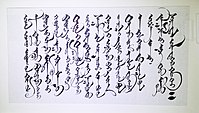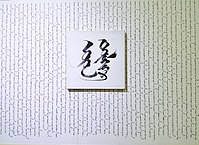
Arabic calligraphy is the artistic practice of handwriting and calligraphy based on the Arabic alphabet. It is known in Arabic as khatt, derived from the words 'line', 'design', or 'construction'. Kufic is the oldest form of the Arabic script.

Calligraphy is a visual art related to writing. It is the design and execution of lettering with a pen, ink brush, or other writing instrument. Contemporary calligraphic practice can be defined as "the art of giving form to signs in an expressive, harmonious, and skillful manner".

A pen is a common writing instrument that applies ink to a surface, usually paper, for writing or drawing. Early pens such as reed pens, quill pens, dip pens and ruling pens held a small amount of ink on a nib or in a small void or cavity that had to be periodically recharged by dipping the tip of the pen into an inkwell. Today, such pens find only a small number of specialized uses, such as in illustration and calligraphy. Reed pens, quill pens and dip pens, which were used for writing, have been replaced by ballpoint pens, rollerball pens, fountain pens and felt or ceramic tip pens. Ruling pens, which were used for technical drawing and cartography, have been replaced by technical pens such as the Rapidograph. All of these modern pens contain internal ink reservoirs, such that they do not need to be dipped in ink while writing.

A qalam is a type of reed pen. It is made from a cut, dried reed, and used for Islamic calligraphy. The pen is seen as an important symbol of wisdom in Islam, and references the emphasis on knowledge and education within the Islamic tradition.

Nastaliq, also romanized as Nastaʿlīq or Nastaleeq, is one of the main calligraphic hands used to write the Perso-Arabic script and it is used for some Indo-Iranian languages, predominantly Classical Persian, Kashmiri, Punjabi and Urdu. It is often used also for Ottoman Turkish poetry, but rarely for Arabic. Nastaliq developed in Iran from naskh beginning in the 13th century and remains widely used in Iran, India, Afghanistan, Pakistan, and other countries for written poetry and as a form of art.

Islamic calligraphy is the artistic practice of handwriting and calligraphy, in the languages which use Arabic alphabet or the alphabets derived from it. It includes Arabic, Persian, Ottoman, and Urdu calligraphy. It is known in Arabic as khatt Arabi, which translates into Arabic line, design, or construction.

Chinese calligraphy is the writing of Chinese characters as an art form, combining purely visual art and interpretation of the literary meaning. This type of expression has been widely practiced in China and has been generally held in high esteem across East Asia. Calligraphy is considered one of the four most-sought skills and hobbies of ancient Chinese literati, along with playing stringed musical instruments, the board game "Go", and painting. There are some general standardizations of the various styles of calligraphy in this tradition. Chinese calligraphy and ink and wash painting are closely related: they are accomplished using similar tools and techniques, and have a long history of shared artistry. Distinguishing features of Chinese painting and calligraphy include an emphasis on motion charged with dynamic life. According to Stanley-Baker, "Calligraphy is sheer life experienced through energy in motion that is registered as traces on silk or paper, with time and rhythm in shifting space its main ingredients." Calligraphy has also led to the development of many forms of art in China, including seal carving, ornate paperweights, and inkstones.

Japanese calligraphy, also called shūji (習字), is a form of calligraphy, or artistic writing, of the Japanese language. Written Japanese was originally based on Chinese characters only, but the advent of the hiragana and katakana Japanese syllabaries resulted in intrinsically Japanese calligraphy styles.

Western calligraphy is the art of writing and penmanship as practiced in the Western world, especially using the Latin alphabet.

Korean calligraphy, also known as Seoye (Korean: 서예), is the Korean tradition of artistic writing. Calligraphy in Korean culture involves both Hanja and Hangul.

Semi-cursive script, also known as running script, is a style of Chinese calligraphy that emerged during the Han dynasty. The style is used to write Chinese characters and is abbreviated slightly where a character's strokes are permitted to be visibly connected as the writer writes, but not to the extent of the cursive style. This makes the style easily readable by readers who can read regular script and quickly writable by calligraphers who require ideas to be written down quickly. In order to produce legible work using the semi-cursive style, a series of writing conventions is followed, including the linking of the strokes, simplification and merging strokes, adjustments to stroke order and the distribution of text of the work.

Ibn al-Bawwāb, also known as Ali ibn-Hilal, Abu'l-Hasan, and Ibn al-Sitri, was an Arabic calligrapher and illuminator who lived in Baghdad. He is the figure most associated with the adoption of round script to transcribe the Qur'an. He most likely died around 1022 CE in Baghdad.

The traditional Mongolian script, also known as the Hudum Mongol bichig, was the first writing system created specifically for the Mongolian language, and was the most widespread until the introduction of Cyrillic in 1946. It is traditionally written in vertical lines Top-Down, right across the page. Derived from the Old Uyghur alphabet, it is a true alphabet, with separate letters for consonants and vowels. It has been adapted for such languages as Oirat and Manchu. Alphabets based on this classical vertical script continue to be used in Mongolia and Inner Mongolia to write Mongolian, Xibe and, experimentally, Evenki.
Indian calligraphy is the Indian tradition of calligraphy. The art form has served multiple purposes since its inception in the second century BCE, including the duplication of religious texts and as a form of basic communication.

Tibetan calligraphy is the calligraphic tradition of writing the Tibetan language. As in other parts of East Asia, nobles, high lamas, and persons of high rank were expected to have high abilities in calligraphy. However, unlike other East Asian calligraphic traditions, calligraphy was done using a reed pen as opposed to a brush. Tibetan calligraphy is at times more free-flowing than calligraphy involving the descendants of other Brahmi scripts. Given the overriding religious nature of Tibetan culture, many of the traditions in calligraphy come from religious texts, and most Tibetan scribes have a monastic background.
Musaddak Jameel Al-Habeeb is an Iraqi American contemporary calligrapher who follows the original traditions in Arabic-Islamic calligraphy. He is self-taught, and never studied under any master calligrapher, according to the traditional norm.
Chinese characters may be written using several major historical styles, which developed organically over the history of Chinese script. There are also various major regional styles associated with various modern and historical polities.

Vietnamese calligraphy relates to the calligraphic traditions of Vietnam. It includes calligraphic works using a variety of scripts, including historical chữ Hán, chữ Nôm, and the Latin-based Vietnamese alphabet. Historically, calligraphers used the former two scripts. However, due to the adoption of the Latin-based chữ Vietnamese alphabet, modern Vietnamese calligraphy also uses Latin script alongside chữ Hán Nôm.

The art of Turkish calligraphy dates back to the seventh century. The Ottoman Turks migrated from Central Asia to establish an empire in Anatolia by 1299, and conquered Constantinople in 1453. The Ottoman Empire became a major European power. After the fall of the Mamluk Sultanate (1517), the Ottomans began to exert great influence over Islamic art and placed great emphasis on calligraphy. They collaborated with Egyptian and Persian calligraphers, adopting the naskh and thuluth scripts.
Calligraphy in Azerbaijani culture is the role played by calligraphy in Azerbaijani literature and visual arts. In the Middle Ages, various examples of calligraphy were used in the writing of Azerbaijani manuscripts, and scientific works were written in the naskh line. In the 19th century, the works "Inshai-Mirza Kazim", "Majmaul-khosh Khatih" by Abdulqani Khalisagarizade Nukhavi and "Khatti-taliq va nastalig" by Abdussalam Akhundzadeh were written. Although calligraphy declined in Azerbaijan during the Soviet era, it is still used in modern times.




























